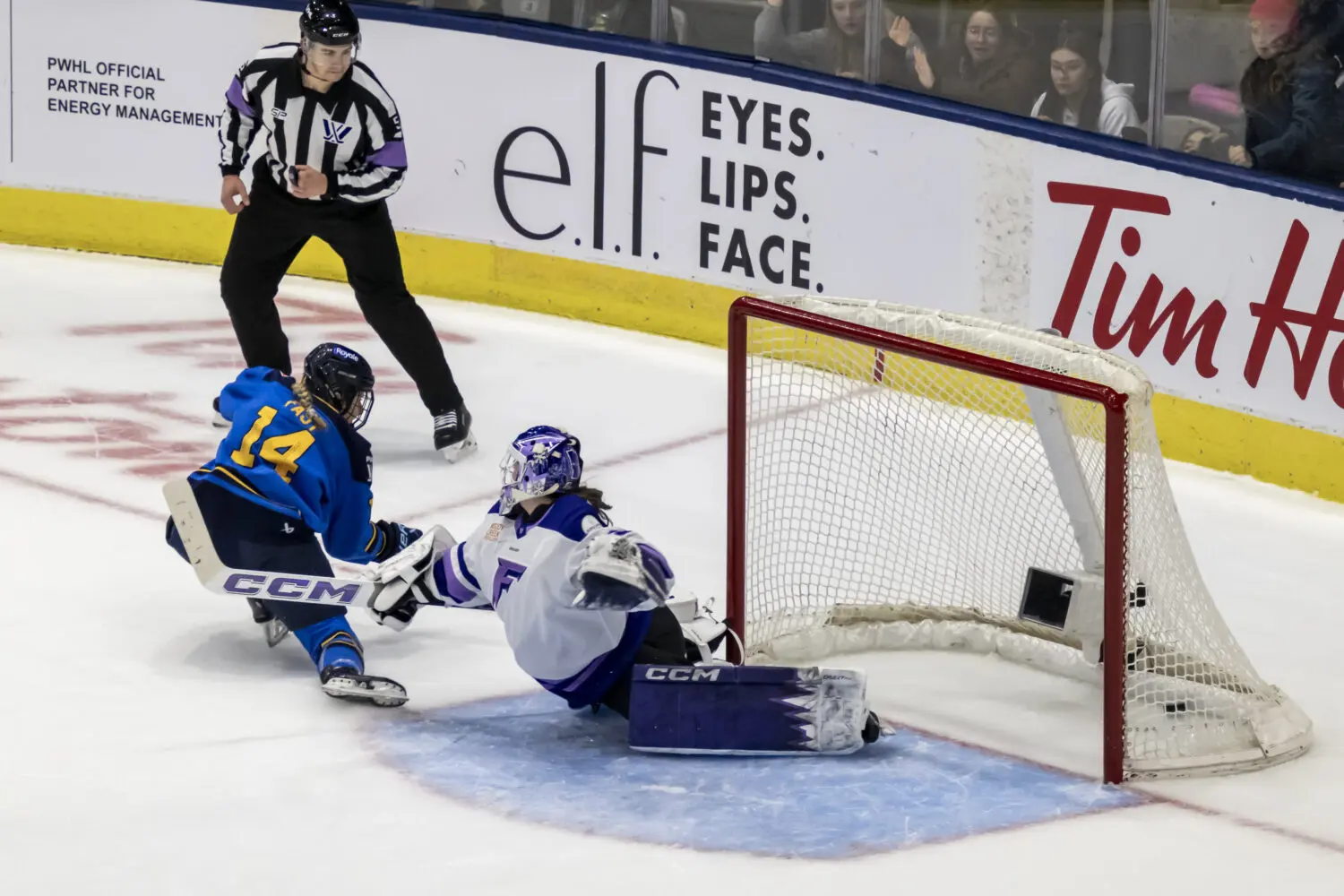My team had been having a very rough season. Week after week, we were losing most games by a score of. . . well, I don’t even know how much we were losing by, but it was usually very lopsided. The scores were so lopsided, in fact, that no matter what happened during the game, by the end of the games, the scoreboard would always say 5-0. As the netminder, this imbalance in scoring was particularly poignant to me. We were playing in the rec division of a women’s rec league, and if our division was recreational, we couldn’t imagine what the competitive division would be like.
In one of the games that stands out as most memorable, we were losing by approximately eight goals with almost the entire third period remaining–I don’t know what the score actually was because the scorekeeper was under instructions to limit the goal difference on the scoreboard to 5 goals. One of the opposing wingers was near the faceoff dot just to my right and took a full-swing slapshot at me, which hit my defender, who was only a few feet away from the shot, right in the chest. About a minute later while I was still trying to figure out what would motivate a team who is up by so many goals to take a close-range and arguably dangerous-for-rec-league slapshot, their team’s superstar, who had certainly surpassed hat trick status already in this game, came cutting in on me very hard with the puck and managed to put it in the net all while violently smashing me into the post and dislodging the net which, along with me, hurtled into the boards.
The refs called off the goal, and I didn’t have time to note the actual reason for their call because I finally snapped and skated after her and loudly asked her why she was playing that way when her team was so far ahead. While animatedly questioning her, I pointed at the scoreboard, which read 5-0 just as it had for probably the past 10 minutes of play. She didn’t answer my question and only said, “Chill out, dude” as my teammates gently but firmly escorted me back to my crease.
About a minute and a half later, she whizzed deftly around my defenders with the puck, netted it and said to me with a smirk, “Is that better?” The score was probably now 9-0, but who would know? I wasn’t sure. The goal scorer wouldn’t have known for sure. The scoreboard still said 5-0.
Throughout this game, the other teams that played in our league with ice times before and after us were filing past the ice pad and surely noticed the scoreboard, taking note for the next time they would play either team currently on the ice. They noticed the lopsided score. I wondered what they thought. And then I wondered what they would think if the actual score had been displayed.
The next week, in the changeroom before the game, I asked my teammates how they felt about asking the scorekeeper to put the actual score on the scoreboard, no matter how one-sided it was. At first my teammates were puzzled as to why I would want the number of goals scored on me (us) to be broadcast to the world, and then a couple of them saw where I was going with this train of thought and agreed. Before the game started, we asked the scorekeeper to put every goal on the scoreboard regardless of the goal difference.
Towards the end of the second period, our opposition scored their sixth goal against us. The score was 6-0. My team reminded the scorekeeper to put the actual score on the board, which she did.
And then, as the third period started, I noticed a funny thing happening. The other team was passing more, involving their less experienced players more, and did not crash our net or take slapshots. I believe they did score another goal, and the scoreboard was updated to show a score of 7-0, and they backed off even more. Our opponents became quite friendly, giving us praise when it was deserved, and they were less physically aggressive. This isn’t to say they weren’t trying; they were just modifying their play a bit because they didn’t need to be so aggressive against my less-experienced team.
The only difference between this game and our prior games that season was the score being accurately shown on the board. For the rest of the season, we asked the scorekeeper to put the true score on the board, and for the rest of the season, there were no more temper flare-ups and no more 8-0 or more losses for my team.
I started thinking about the reason that scorekeepers will often limit the score difference shown on the scoreboard. In my capacity as a timekeeper for a men’s league, I was also asked to not show more of a goal difference than 6 goals, and this mandate is traditionally and ostensibly to protect the losing team from humiliation and the ridicule of onlookers. But in a recreational league, who is this scoreboard manipulation actually protecting?
A few months ago, I was running the scoreboard for the men’s league, and one of the games was clearly mismatched–the league convener obviously needed to either move one team up or one team down a division. The score was 9-0 by the middle of the second period. Even though I’d been directed to put only a goal difference of max 6 goals on the board, I contemplated what those in the arena sports bar watching would think about the true score line. I hoped, and maybe this hope is drastically misplaced, but I hoped that anyone watching would think, “Why is that team continuing to run up the score against an obviously less-skilled opponent? What poor sportsmanship!” I didn’t think that many people would see the score and think the losing team was merely a laughingstock.
Just before the third-period puck drop, I leaned out of the scorekeeper booth and said to the losing team’s bench, “Hey, just so you know, the reason I have the actual score on the board is so that anyone who is watching can see that the guys are on the other team are jerks.” The players pondered the statement for a few seconds, then all the previously grimacing faces broke into smiles and one of the players said, “Hey, good idea. Keep putting their goals up!”
Nothing says poor sportsmanship to me more than running up the score. And even those who defend scoring at every opportunity are still a bit uneasy about running up the score, especially if their lack of restraint is emblazoned on the scoreboard for everyone to see. No doubt opinions vary as to when scoring as often as possible at all costs is acceptable, and no doubt leagues and tournaments that factor goal difference into standings are partially responsible for this behavior, but that is not what I am discussing here.
Some may say that a team that backs off when they are well ahead in the score, particularly against an obviously weaker team, is, in reality, doing a disservice to the game and to their opponent. However, there are ways that a team can still play hard and improve their skills without trouncing their opponent.
This summer, for once in my life, I actually happened to be on the opposite side of the equation, playing winger on a tournament team that found itself on the upside of an 8-0 score. The scoreboard was halted at 5-0, and from 4-0 onwards, I was finding myself increasingly uncomfortable every time our star center scored again. While on the bench, the star center, observing another of our team’s lines playing a bit less aggressively than in the previous periods, began complaining that we weren’t trying hard enough to score. I said incredulously, “Woah, we are up 8-0. We don’t need any more goals!” She looked at me with a confused expression and, while gesturing towards the scoreboard said, “No, the score is only 5-0!” I assured her that it was 8-0 but they were holding the goal difference on the board at 5, and after that explanation, she changed her tune completely and agreed that we should probably back off.
So I ask the question again—when the scoreboard downplays the actual goal difference, which team is it that inaccuracy is really protecting? The scoreboard has an interesting story to tell—let that story be told.
[adrotate group=”1″]
Related Articles
Categories
Recent Posts
[adrotate group=”2″]














